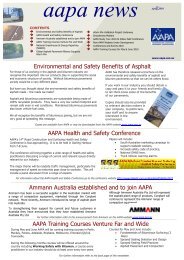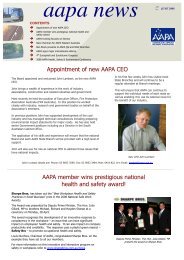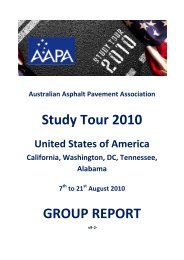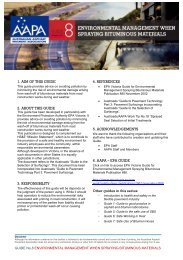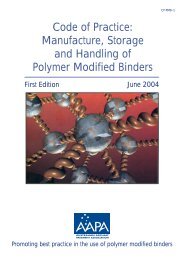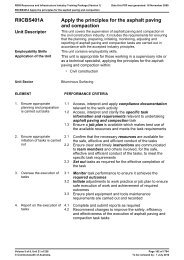Asphalt Review - Volume 29 Number 2 (June / July 2010)
Asphalt Review - Volume 29 Number 2 (June / July 2010)
Asphalt Review - Volume 29 Number 2 (June / July 2010)
Create successful ePaper yourself
Turn your PDF publications into a flip-book with our unique Google optimized e-Paper software.
ASPHALT REVIEW<br />
Foamed bitumen<br />
The quantities of residual bitumen emulsion or foamed<br />
bitumen added do not typically exceed 3% by mass of dry<br />
aggregate. In many situations, active filler in the form of<br />
cement or hydrated lime is also added to the mix. The cement<br />
content should not exceed 1%, and should also never exceed<br />
the percentage of the bitumen stabiliser. If more cement than<br />
bitumen is added, then the material should be considered a<br />
cement treated material and the relevant guidelines for such<br />
materials followed.<br />
The addition of bitumen emulsion or foamed bitumen to<br />
produce a BSM results in an increase in material strength<br />
and a reduction in moisture susceptibility as a result of the<br />
manner in which the bitumen is dispersed amongst the finer<br />
aggregate particles. The “non-continuous” binding nature<br />
of the individual aggregate particles makes BSMs different<br />
from all other pavement materials. The dispersed bitumen<br />
changes the shear properties of the material by significantly<br />
increasing the cohesion value whilst effecting little change to<br />
the internal angle of friction. A compacted layer of BSM will<br />
have a void content similar to that of a granular layer, not<br />
an asphalt. BSMs are therefore granular in nature and are<br />
treated as such during construction. The failure mechanism<br />
for BSMs in a pavement structure subjected to repeated axle<br />
loads is permanent deformation, not fatigue cracking. BSMs<br />
are therefore more closely related to granular materials than<br />
to asphalt concrete.<br />
The behaviour of BSMs, relative to other pavement materials<br />
is illustrated in Figure 1.<br />
Condensed version - full version available from Conference<br />
papers 2009 - aapa@asn,com.au<br />
TG2, SECOND EDITION<br />
The research feeding into this publication took five years and<br />
was officially launched in May 2009 at a series of seminars<br />
held in the main cities around South Africa. The attendance<br />
of almost 300 delegates at these seminars was an indication<br />
of the level of interest shown by industry and subsequent<br />
feedback suggested that this technology will be adopted more<br />
widely in future, mainly as a result of a better understanding<br />
of material behaviour (especially the failure mechanism),<br />
coupled with the new simplified design procedures.<br />
Also appreciated was the decision taken to house the<br />
technology on <strong>Asphalt</strong> Academy’s website, allowing the 136-<br />
page manual to be downloaded in pdf format at no cost.<br />
All new and non-standard laboratory test methods for mix<br />
designs are also housed on the website rather than included<br />
in the manual.<br />
Another feature of the website is the inclusion of the<br />
programs for material classification and pavement design.<br />
Although these programs cannot be downloaded, users can<br />
access the website at any time, log on and use the software,<br />
free of charge. Input data and results can, however, be stored<br />
on the individual’s computer.<br />
It is envisaged that this website will receive ongoing<br />
development as more users provide feedback and additional<br />
information is obtained from research initiatives.<br />
The manual introduces the abbreviation BSM for a “bitumen<br />
stabilised material” and incorporates both bitumen emulsion<br />
treated material as “BSM-emulsion” and foamed bitumen<br />
treated material as “BSM-foam”. Regardless of which form<br />
of treatment is adopted, the resulting BSM is regarded as a<br />
generic product from a design and performance perspective.<br />
However, the most important feature of the new design<br />
approach is the direct relationship between the engineering<br />
properties of the materials in the various layer components<br />
and pavement performance.<br />
The new mix design procedures<br />
Figure 2 illustrates the three levels of tests that have been<br />
adopted for classifying the product into one of three BSM<br />
classes. The level of testing required is dictated by the design<br />
traffic (structural capacity requirement); the higher the level<br />
of testing, the greater the level of confidence achieved.<br />
Figure 2. Mix design flowchart Condensed version - full<br />
version available from Conference papers 2009 - aapa@<br />
asn,com.au<br />
TG2 Second Edition classifies BSMs into three classes,<br />
depending on the quality of the parent material, the effectiveness<br />
of stabilisation and the design traffic. The three classes are:<br />
BSM1: This material has a high shear strength<br />
BSM2: This material has moderately high shear strength<br />
BSM3: This material typically consists of soil-gravel and/or<br />
sand stabilised with higher bitumen contents.<br />
Table 1 summarises the boundary values for the various test<br />
results that are the primary indicators used to classify BSMs into<br />
one of three classes. Also shown are the CF values for each test.<br />
The new approach to pavement design<br />
The structural design of pavements in TG2 Second Edition<br />
utilises a knowledge-based approach that uses a Pavement<br />
<strong>Number</strong> (PN) that is based on AASHTO’s Structural <strong>Number</strong><br />
concept. However, the shortcomings of the Structural <strong>Number</strong><br />
method have been addressed in developing this PN method.<br />
This method was based on a plethora of data collected from<br />
numerous in-service pavements where the type and detail of the<br />
data suggested that a relatively simplistic method be adopted<br />
(it also precluded the use of a Mechanistic-Empirical design<br />
approach).<br />
Rules relating to pavement systems/ Rules relating to specific<br />
pavement layers:<br />
Condensed version - full version available from Conference<br />
papers 2009 - aapa@asn,com.au<br />
BSMs are assumed to act in a similar way to coarse granular<br />
materials but with a higher cohesive strength. Although not<br />
confirmed, the cohesive strength is presumed to reduce as a<br />
consequence of repeated loading and thus some softening may<br />
30 ROADS JUNE <strong>2010</strong>/JULY <strong>2010</strong>



